JAMES BOND
|
||
|
||
JAMES BOND
|
||
|
||
|
||||
|
Part 5: Never Again? |
||||
|
|
||||
|
Connery followed Outland with the starring role as news reporter Patrick Hale in maverick American director Richard Brooks' comedy thriller Wrong Is Right (1982) [released in the UK as The Man With The Deadly Lens]. The 1982 satire failed to find an audience and was another box-office failure, despite having a James Bond-style painted poster which once again pictured Connery surrounded by bikini-clad girls - an image that has nothing to do with the content of the film. In a bizarre sequence, Sean Connery even breaks the fourth wall by looking directly at the camera, removing his toupee and tossing it aside before leaping out of an aircraft! |
||||
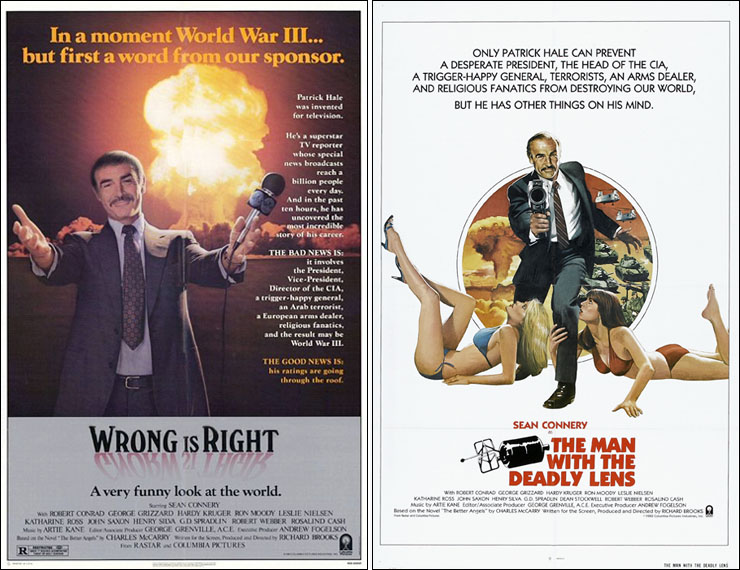 |
||||
|
Also in 1982 Sean Connery starred in Five Days One Summer, which turned out to be the final film from acclaimed Austrian director Fred Zinnemann (1907-1997). Connery plays a middle-aged Scottish doctor on vacation in the Swiss Alps in 1932, who romances his niece whom he is passing off as his wife. Co-starring in Five Days One Summer was French actor Lambert Wilson, who would test for the role of James Bond himself in 1986. In the screen test Wilson spoke Sean Connery’s dialogue from the From Russia With Love bedroom scene with Maryam d’Abo as Tatiana Romanova, before dealing with the obligatory bad guy in the form of stuntman Doug Robinson (brother of Joe Robinson [Peter Franks in Diamonds Are Forever]). |
||||
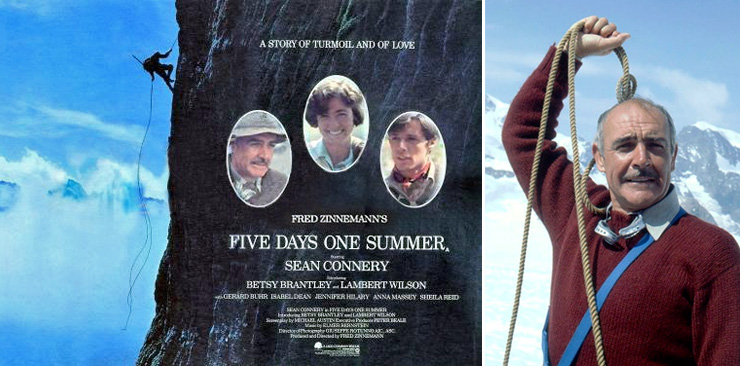 |
||||
|
Five Days One Summer was once again a critical and commercial disaster, and it appeared that Connery had lost his footing in the early Eighties, with his unusual choice of projects. However, all that was about to change as in 1982 it was announced that Sean Connery would return to the role of James Bond once more, in a film based on the screenplay he had co-written with Len Deighton and Kevin McClory. Sean Connery had first been approached by producer Kevin McClory in 1975 during the post-production of The Wind And The Lion. Kevin McClory still retained the film rights to the ‘Thunderball’ story he had written with Ian Fleming and Jack Whittingham, but could not make another film version until ten years after the release of the EON Productions version of 1965. The screenplay was titled ‘Warhead’, and the three men worked as a team, both in Ireland and at Connery’s home in Marbella over the course of four months. The screenplay featured Ernst Stavro Blofeld, the head of SPECTRE, working from an underwater fortress called Aquapolis. Connery, unaware that legally they had to stick to the plot of the original, enthusiastically spoke about the finished screenplay, “You know these aeroplanes that were disappearing in the Bermuda Triangle? We had SPECTRE doing all that. There was this fantastic fleet of planes under the sea; a whole world of stuff had been brought down. They were going to attack the financial nerve centre of the United States by going in through the sewers of New York, which you can do, right into Wall Street. They’d have mechanical sharks in the bay and take over the Statue of Liberty, which is quite easy, and have the main line of troops on Ellis Island.” Connery even took part in location scouting in New York in 1975 and pre-production artwork from 1978 featured the mechanical sharks mentioned in the script. Albert R. Broccoli and EON Productions were concerned that McClory was breaching his rights, and that the ‘Warhead’ screenplay was more than just a simple re-make of Thunderball, and that he was in fact introducing new material. Once producer Jack Schwartzman was brought on board as producer he knew that another costly legal battle with EON was out of the question and the ‘Warhead’ script was scrapped. A new story closer to the original Thunderball outline was written by Lorenzo Semple Jr., but Connery was unhappy with this and brought in the British comedy-writing team of Dick Clement and Ian La Frenais to add more humour. |
||||
|
|
||||
|
Once Sean Connery had finally agreed to star as James Bond once again he would collect a $3-million dollar pay packet plus a share of the profits. Although Sean Connery had approved of director Irvin Kershner having worked together on A Fine Madness in 1966, the shooting of the film which was now titled Never Say Never Again [at the suggestion of Connery's second wife Micheline], was a very troubled affair, with many potential collaborators turning down the offer of working with Connery again due to their loyalty to ‘Cubby’ Broccoli and the EON Productions series. Connery himself even temporarily left the production during shooting to take a supporting role in the 1982 fantasy film Sword Of The Valiant. Filming on Never Say Never Again was finally completed at Elstree Studios in spring 1983, following location shooting in France and The Bahamas. |
||||
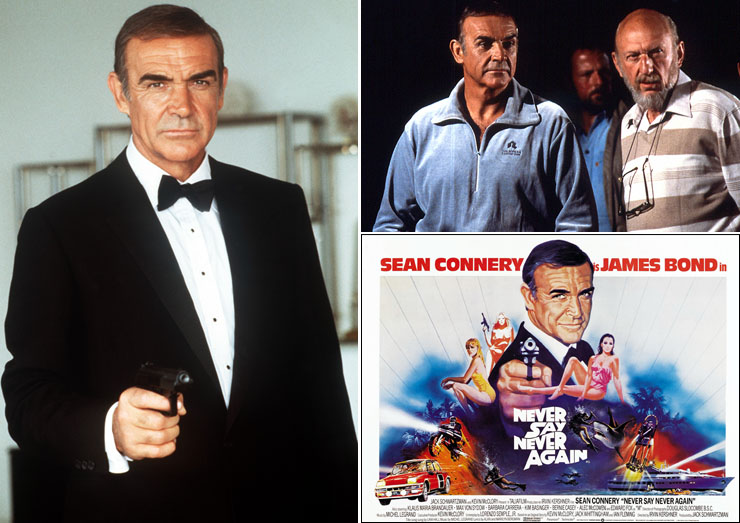 |
||||
|
Both Octopussy and Never Say Never Again were gearing for a head-to-head at the box-office in the summer of 1983, but the anticipated ‘Battle of the Bonds’ showdown between the two films never materialised. Octopussy was given a clear run after Never Say Never Again was rescheduled to a winter release. Whether this was due to legal or logistical reasons – or just plain common sense is unknown. Never Say Never Again also survived a last ditch attempt to block its release, brought at the High Court in London by Ian Fleming’s trustees in the spring of 1983. The Trustees alleged that considerable secrecy had surrounded the making of Never Say Never Again, but had made no move to stop the film, apparently because they were unaware of its existence! Never Say Never Again was released in the USA on October 7, 1983 and recouped almost $10-million in its opening weekend, a fact that distributor Warner Bros. were only happy to promote. |
||||
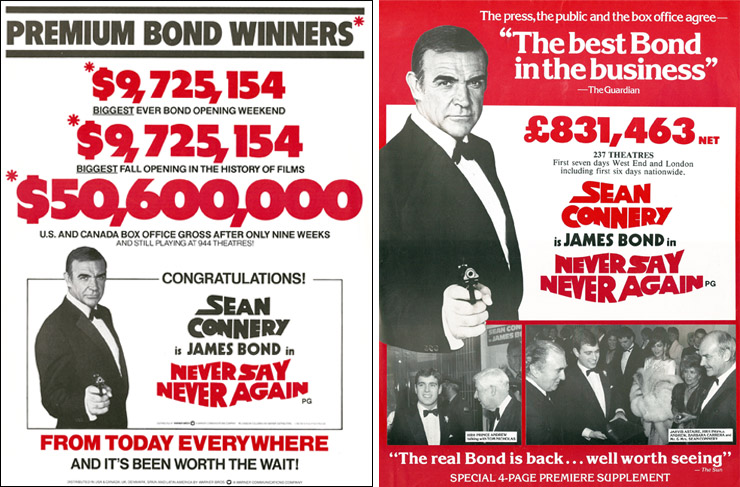 |
||||
|
Although Octopussy ultimately outperformed Never Say Never Again at the box-office in 1983, Sean Connery's comeback was still a huge international success, with fans rejoicing in his return to the role with which he was still synonymous. Never Say Never Again was eventually released in the UK following a West End Royal Charity Premiere on December 14, 1983. In the week before its UK opening Sean Connery made several appearances on TV shows to promote Never Say Never Again. The National Film Theatre also ran a season of most of Sean Connery's films for the first two weeks of December, starting with a double-bill of Dr. No/From Russia With Love. For many the season was a chance to re-evaluate Connery's non-Bond career, and many films were being seen for the first time in many years. As if to remind cinemagoers that Never Say Never Again was a remake, EON Productions also re-released Thunderball on a triple-bill with For Your Eyes Only/Octopussy for an exclusive two-week engagement at the Empire Cinema Leicester Square from Friday December 9th; whilst Diamonds Are Forever joined the two most recent Roger Moore films playing simultaneously at the ODEON Marble Arch. |
||||
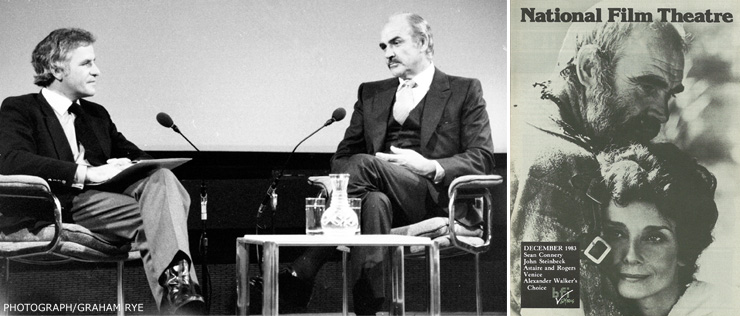 |
||||
|
Sean Connery was also honoured with a Guardian Lecture at the National Film Theatre on London's South Bank on the evening of Tuesday December 13, 1983, where he was interviewed on stage by film critic Iain Johnstone (1943-2023). Sean Connery was visibly deeply moved by the reaction he got from the capacity audience, and with the UK premiere of Never Say Never Again taking place the following evening, he was finally back on top with a huge international hit - his first for several years. |